Eight hundred kilometres north of the Arctic Circle, the analysis vessel Kronprins Haakon drifts quietly by means of a thick pack of ice floes. The sky and sea are bathed in purple morning mild as Alexandra Stephens, a PhD pupil on the College of Toronto Mississauga, Canada, pilots a drone over the frosty expanse, looking for warmth.
Though it doesn’t seem like it, the Arctic waters are balmy in February, relative to the air temperatures, which may fall under −30 °C. On the display of Stephens’s distant management, the pancake-shaped floes present up within the thermal photos as darkish circles, whereas open water and skinny ice glow shiny orange, indicating vitality escaping from the ocean into the frigid polar air.
The switch of warmth from ocean to ambiance is on the coronary heart of some of the vital elements of Earth’s local weather — a system of currents that snakes throughout all the size of the Atlantic Ocean and transports heat water from the tropics to excessive northern latitudes. Recognized by the unwieldy title of the Atlantic Meridional Overturning Circulation (AMOC), this community of currents impacts climate situations for billions of individuals around the globe. It’s the rationale that north-western Europe is comparatively gentle within the winter and far hotter than Labrador in Canada, which is at an identical latitude.
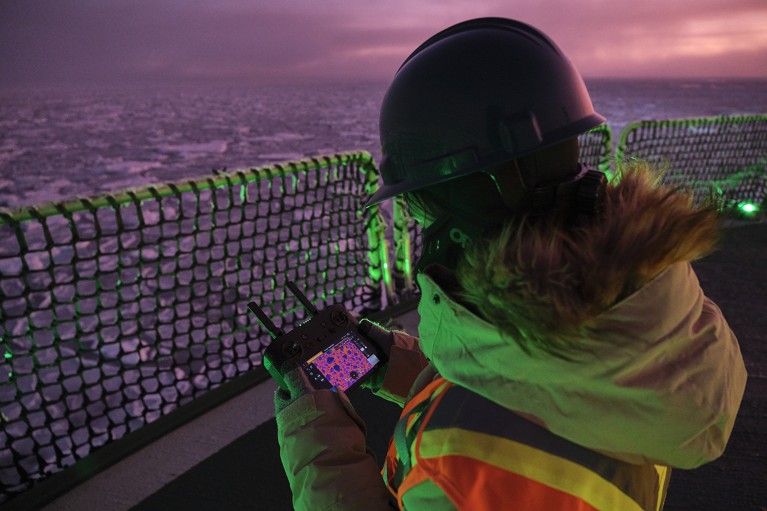
Alexandra Stephens pilots a drone that collects knowledge on warmth escaping from the ocean.Credit score: Tim Kalvelage
However scientists are more and more involved that this significant present system is weakening because the planet is getting hotter due to greenhouse-gas air pollution build up within the ambiance. Some pc local weather simulations warn that the AMOC might attain a tipping level within the twenty-first century and lose a lot of its power. This is able to have catastrophic impacts throughout the globe; one examine printed final 12 months initiatives that temperatures in north-western Europe might drop by as a lot as 15 °C, plunging the area into a brand new ice age, whereas the southern hemisphere would undergo extra extreme warming1. It additionally suggests {that a} near-collapse of the AMOC would drive disruptive modifications in rainfall within the Amazon basin. “The results of an AMOC collapse can be so excessive that it will likely be tough for us to adapt,” says bodily oceanographer Henk Dijkstra at Utrecht College within the Netherlands, a co-author of the examine.
Regardless of its significance, the AMOC is likely one of the massive unknowns in projections about Earth‘s future local weather. Researchers have little details about how the present system is altering — notably within the polar North Atlantic, a key area for the AMOC. That’s what introduced the Norwegian ice-breaker RV Kronprins Haakon to the western Greenland Sea in February as a part of a venture often called ROVER, which is funded by the European Union. With its strengthened hull, the ship can enterprise into the ice-covered area to gather valuable knowledge on how the AMOC would possibly evolve.
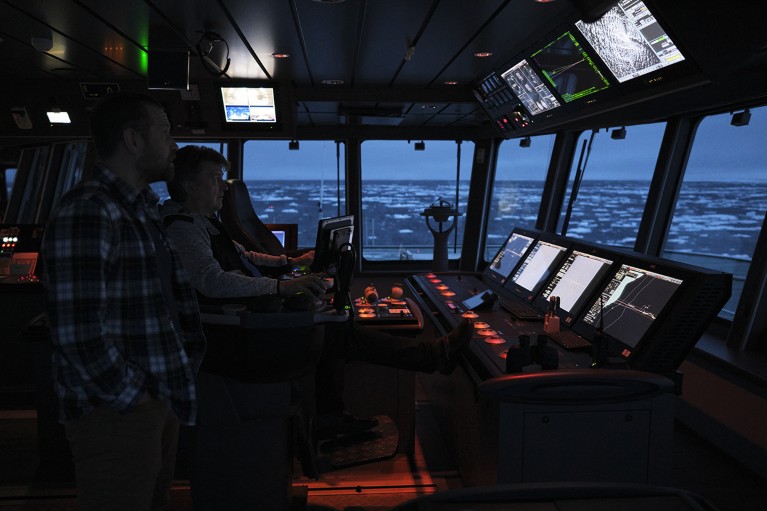
On the bridge of Kronprins Haakon at daybreak, chief scientist Kjetil Våge (left) and captain Hallgeir M. Johansen focus on the route by means of the ocean ice. Credit score: Tim Kalvelage
“This can be a very sparsely sampled space, particularly in winter when hardly anybody ever goes out right here,” says Kjetil Våge, a bodily oceanographer on the Bjerknes Centre for Local weather Analysis in Bergen, Norway, who’s main the ROVER mission. He suspects the lack of sea ice close to Greenland brought on by international warming would possibly truly assist to stabilize the AMOC and forestall it from slowing as a lot as individuals concern.
I joined the ROVER expedition in February because it collected knowledge that may take the heartbeat of the AMOC and assist researchers to evaluate the way it will change in coming many years.
Crossing currents
Because the RV Kronprins Haakon left Norway’s Svalbard archipelago at the beginning of the expedition, the Arctic was nonetheless veiled within the perpetual darkness of the polar evening. The far-reaching affect of the AMOC was apparent as we crossed Fram Strait, which separates Svalbard and Greenland (see ‘Winter journey’). On the primary a part of the journey, the ship handed by means of northward-flowing Atlantic waters that saved the ocean ice free. As we left that present, the Kronprins Haakon shortly encountered heavy pack ice from the Arctic Ocean drifting south.
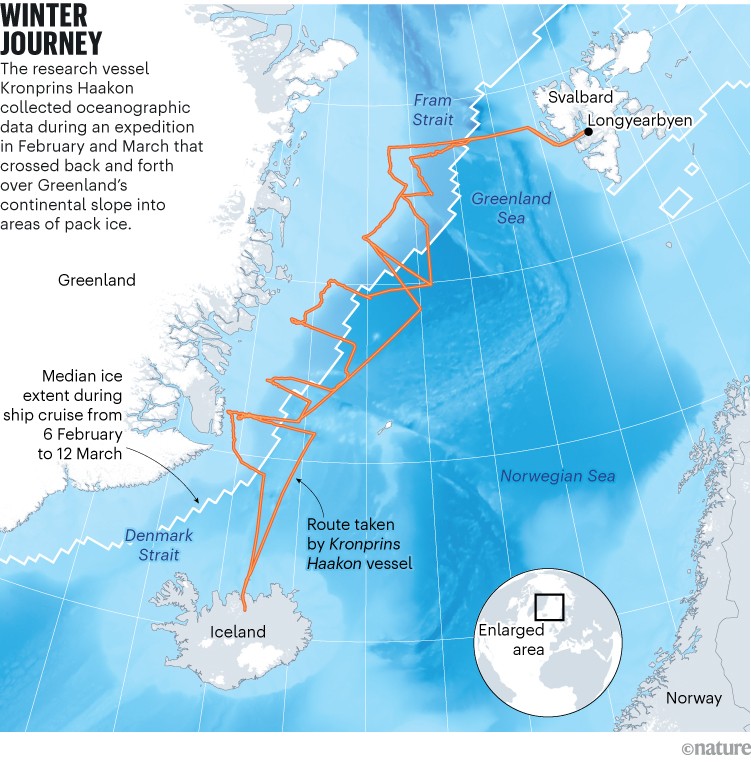
Sources: Bathymetry: GEBCO; Ice extent and glaciers: NSIDC; Greenland ice sheet: ESA Glaciers CCI; Cruise knowledge: Kjetil Våge
The AMOC is commonly described as a conveyor belt — a extremely simplified however apt description as a result of its higher currents and deeper ones transfer in reverse instructions. Within the Northern Hemisphere, the floor strands, which embody the Gulf Stream, carry heat and salty water from the equator in the direction of the pole. At excessive latitudes that water releases big quantities of warmth into the ambiance that helps to heat elements of Europe in winter.
When the floor water of the AMOC cools off, it turns into dense sufficient to sink into the abyss within the North Atlantic close to Greenland, which locks away big quantities of carbon dioxide and provides oxygen to the deep sea. At depth, the water flows south till it resurfaces once more close to Antarctica (see ‘Warmth flows’).
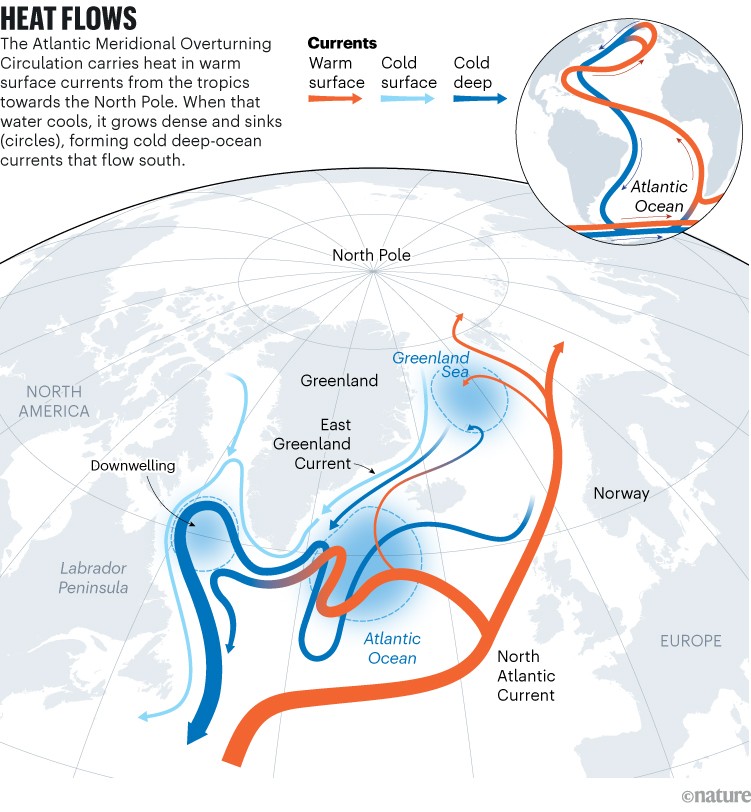
Sources: S. Rahmstorf Oceanography 37, 16–29 (2024)/R. Curry and C. Mauritzen Science 308, 1772–1774 (2005)
Pc local weather simulations recommend that international warming might disrupt the present system in a number of methods: as air temperatures within the Arctic and subarctic improve, the floor water doesn’t cool as a lot in winter, which retains it from getting as dense because it usually would. One other issue at play is the melting of sea ice and the Greenland ice sheet. This melting provides contemporary water to the uppermost ocean, lowering the density of the floor water much more. These modifications inhibit the sinking that drives the AMOC2.
It’s not only a theoretical concern that this might occur: proof from Earth’s previous suggests that there have been abrupt shifts within the power of the AMOC between ice ages and heat intervals3.
Considerations in regards to the future prompted scientists to start out monitoring the Atlantic Ocean within the early 2000s. To trace what is going on with the AMOC, worldwide analysis consortia have anchored devices to the ocean mattress at numerous latitudes throughout the ocean’s basin to measure water temperature, salinity and present velocity. The longest-running programme, RAPID-MOCHA, has gauged the power of floor and deep-ocean currents of the AMOC since 2004 within the subtropics at 26° N. One other effort, referred to as OSNAP, screens the AMOC at greater than 50 websites from Labrador to South Greenland to Scotland.
Thus far, their data present appreciable variability however no constant modifications in how a lot water the AMOC strikes4,5. The time span of the observations is just too quick to make out a development, says Susan Lozier, a bodily oceanographer on the Georgia Institute of Expertise in Atlanta, and head of OSNAP. “We’re on this messy center of making an attempt to know what is going on with the overturning circulation.”
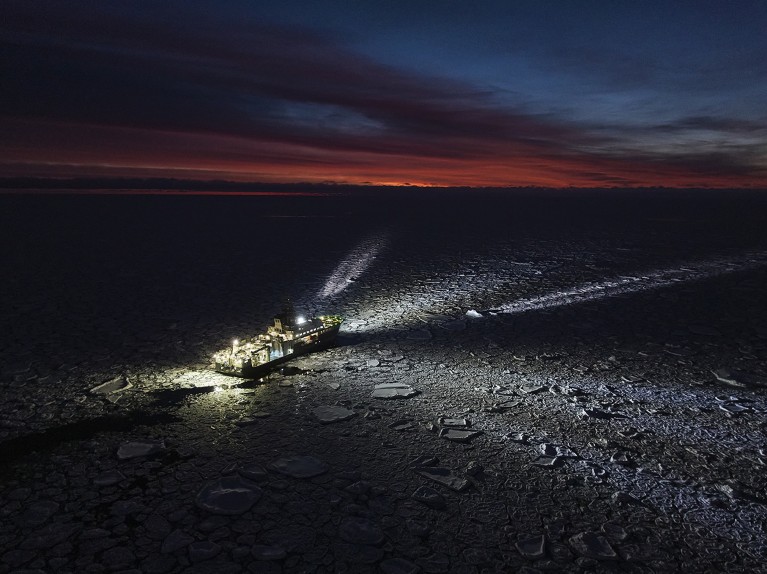
The ship travels by means of the pack ice of the Greenland Sea close to 76° N at daybreak.Credit score: Tim Kalvelage
As a result of researchers have solely twenty years of direct present measurements, they depend on oblique technique of gauging the power of the AMOC. For instance, data of sea floor temperatures present that the subpolar North Atlantic has cooled because the Nineteen Fifties whereas the ocean as a complete has warmed: some scientists interpret the cooling as an indication of a discount within the quantity of heat water from the subtropics reaching the area, which might correspond to a 15% decline within the power of this present system6. Others, nonetheless, have discovered the AMOC to be steady for the previous few many years7.
A number of modelling research prior to now few years warn that the AMOC might weaken drastically within the close to future — as much as the purpose of inflicting a near-shutdown. A collapse wouldn’t occur abruptly however would take 50–100 years, says Stefan Rahmstorf, a local weather scientist on the Potsdam Institute for Local weather Impression Analysis, Germany. Past a vital tipping level, nonetheless, an extra decline is unstoppable. “I feel there’s a 50–50 likelihood that we’ll cross the tipping level this century,” he says.
The concept the AMOC is heading for collapse is controversial. The query is, can local weather fashions realistically simulate the current and due to this fact produce dependable forecasts? To take action, scientists want observations to judge and refine their fashions, says Ben Moat, a bodily oceanographer on the Nationwide Oceanography Centre in Southampton, UK, and one of many heads of RAPID-MOCHA. “Observations are crucial to our understanding of what‘s occurring to the longer term AMOC.”
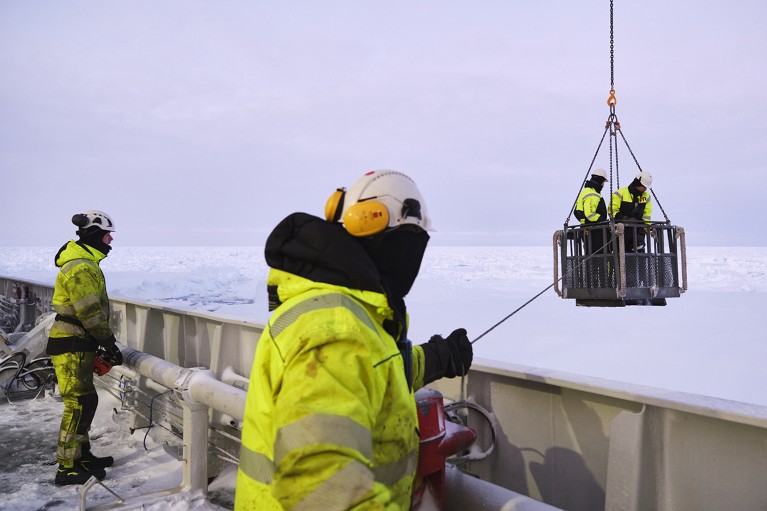
Scientists deploy a buoy within the Greenland Sea to review sea ice.Credit score: Tim Kalvelage
Våge thinks that processes within the Nordic Seas north of Iceland, which aren’t nicely resolved by present local weather fashions, might assist to determine the destiny of the AMOC. That’s why his group ventured into the icy waters of the Arctic in February.
Hidden warmth
Early one afternoon, the Kronprins Haakon stops some 250 kilometres off the coast of Greenland. The ship’s crew opens a big hydraulic hatch within the hangar on the primary deck and lowers a metallic body carrying 24 empty bottles and a collection of sensors, referred to as a CTD rosette, into the ocean. Doctoral pupil Erika Giorgi on the Bjerknes Centre for Local weather Analysis watches the information getting back from the CTD rosette because it sinks to a depth of two,090 metres. “It’s thrilling to be out right here in winter and see these measurements in actual time,” she says. The temperature of the water climbs from −1.8 °C on the floor — the freezing level of seawater — to about 2 °C at 200 metres, earlier than dropping once more to under zero in the direction of the underside.
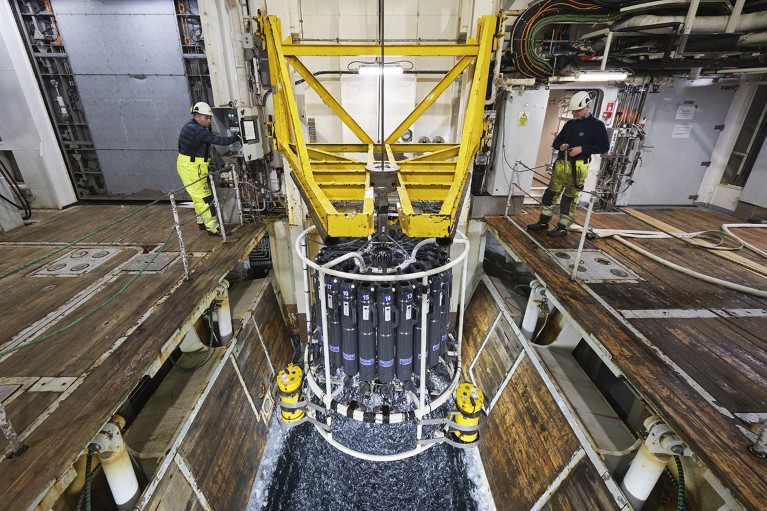
A tool referred to as a CTD rosette collects water samples and measures present flows and different properties.Credit score: Tim Kalvelage
The layer of comparatively heat and salty water is what pursuits the researchers essentially the most. It’s water that had beforehand flowed north by means of the Atlantic, taken a U-turn in Fram Strait or made a loop across the Arctic Ocean and is now travelling south within the East Greenland Present. Because it continues west of Iceland, the dense subsurface water of this present crosses a marine mountain ridge and cascades down into the abyssal North Atlantic. This makes it a significant supply for the deep department of the AMOC and one of many prime topics that the ROVER venture goals to review.
Prior to now, the East Greenland Present has been absolutely coated by sea ice in winter, which allowed little warmth to flee from the ocean. However with rising temperatures prior to now few many years, the wintertime ice cowl on this area has been shrinking. That is exposing the East Greenland Present to extraordinarily chilly polar air, which might assist to spur water to sink — a vital a part of the overturning circulation. For Giorgi, this chance offers “a glimmer of hope” in contrast with the largely gloomy future eventualities of the AMOC.
Våge means that deep-water formation pushed by intense warmth loss on this area might make the AMOC extra resilient to local weather change than some researchers have assumed. He factors to some pilot knowledge from a earlier examine8 that help his speculation of enhanced warmth loss alongside the East Greenland Present. “However we have no idea how a lot or how vital it’s,” he says.
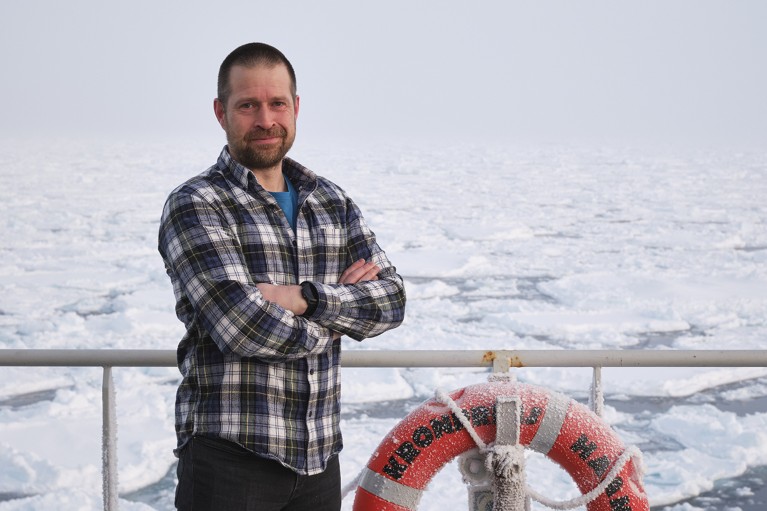
Chief scientist Kjetil Våge on deck within the ice-covered Greenland Sea.Credit score: Tim Kalvelage

